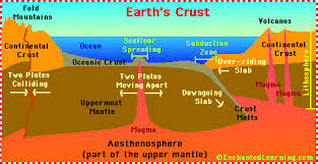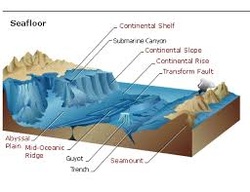I was going to title this “The Beginning of The Most Important Shift in ERP” but it A) didn’t work as a headline and B) didn’t allow me to use cool geographic illustrations in the blog post. Which I know half of you are just here for the pictures – so onward.
I’ve written before about a couple of trends – Stages companies go through as they grow, with what they seek in ERP along the way and Post PC Consumerization of IT – or the fact that there has to be a better, less expensive, less complex way to approach ERP. Those tectonic plates are colliding – and here’s the result.
Post PC Consumerization of IT – is a trend that’s leaving behind the old, three-letter acronym (ERP, WMS, CRM…et cetera) world of buy a million dollar software package and spend a million dollars getting it up and running – to a world where we just download the app and it works. ERP’s not that simple yet – but the companies sticking to the old legacy model are starting to enjoy some real butt-kickings in the market.
I’ve noticed a strong trend starting about a year ago and is really accelerating in 2014. (I’ve been proposing it for three or four years, but either I’m suddenly more persuasive or customers are really ready for the shift)
In any case, I came across this article by Shelton Hill – an analyst with Studio B and a gent who’s been recognized by the Missile Defense Agency, which is as close as the software industry gets to an actual rocket scientist.
He writes:
Today, there’s a demonstrative shift from big ERP systems to componentized ERP environments. Componentization is the breaking apart of these massive [ERP] systems into smaller, functional components or modules, like financials, supply chain, management, and human resources. These separate modules can stand alone or be integrated into all-inclusive, overarching systems. Instead of having to upgrade and implement an entire system to gain additional functionality, a company need only incrementally upgrade and deploy a specific component.
As I mentioned before, this has been possible for some years, but not adopted until recently.
The catalyst for componentization was the economic recession that began in 2008. IT budgets contracted and organizations had to do more with less. Because of the coinciding innovations in cloud technology, instead of deploying and implementing traditional ERP infrastructure, organizations started adopting a two-tier, or hybrid, ERP model.
Sheldon cites the tight budgets of recent years – I’d also say Salesforce.com broke a lot of ground here. Risk averse CFO’s were very reticent to put sensitive financial data ‘on the web’ (which is how people used to talk before we came up with the term ‘cloud’) prior to Salesforce. And the sneaky part is, CFO’s didn’t mind sales data in the cloud, just don’t talk to them about financials – until someone pointed out, we’ve had the very data that creates our ‘financials’ cloud-based for the last 5 years and nothing bad has happened.
By breaking up ERP into functional modules or components, the lofty goals of ERP are finally becoming practical and achievable.
Which I think is the actual point.
It’s really hard to talk about ERP budgets because the guys who are spending $100k are put off by talk of millions and the guys spending millions think smaller numbers reduce legitimacy – so we’re going to talk about your ERP budget as $10 – just for comparisons sake.
So here’s the choices
LEGACY – the old, legacy model of ERP was, set the budget for $10 – end up buying the best legacy system we can afford. It’s $5 to license the software and $5 for the consulting services to get it up and running. Unfortunately, the average ERP implementation is 186% of budget, so you end up spending $19 dollars, it takes a year to 18 months to get up and running – and then…not everything works just like you remember from the demo. The WMS system has a few limitations, CRM isn’t really doing what we thought it would…but it’s working, everyone’s breathing a sigh of relief that the project is over – so this is what we live with.
COMPONENT – here, we’re licensing a SaaS model, cloud based ERP, primarily for our financials, but with purchasing, AR. AP – everything the back office is doing. We spent $2 on the licensing this year and $1 getting it up and running (remember, this is a far simpler package than our Legacy ERP so it’s much less to configure and install). We also spend $3 on our Point of Sale (POS) system and we spend $2 on a systems integrator group to link all our POS terminals to the financials. That leaves $2 to invest in BI (Business Intelligence) which allows us to take data from all our systems into a data warehouse to create dashboards and keep an eye on the KPI’s that make our business hum. Altogether, we’ve put all three systems up in a fraction of the time we might have spent on one Legacy system.
Granted, because the Financials are a SaaS model, we’ll have $2 in licensing costs in year two, and each year thereafter. But we’re focusing on the part of the business that drives our success, instead of trying to fit Legacy rules and workflow into what we’re doing already.
In closing – I’ve talked about this trend, and seen it with my own client base – Shelton Hill confirms it among his circle of expertise. I think we’re on the first generation of SaaS ERP – it’s less expensive, easier to configure, easer to integrate and much quicker to go live – those trends will only continue.
Will it soon be ERP as a downloadable app?
Not quite there yet – but we’re a shifted world away from the old Legacy ERP packages.
Contact gh@genehammons.com




